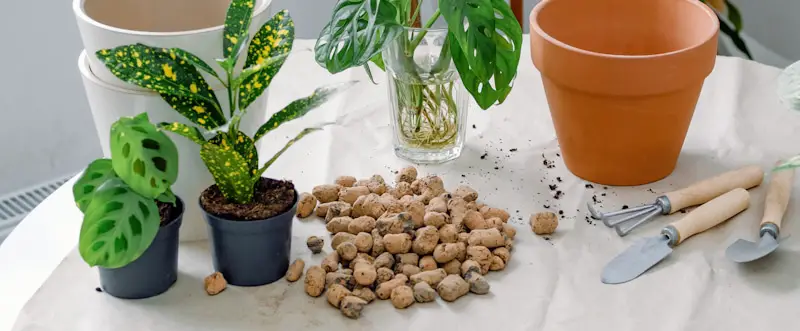Prayer plants are beautiful indoor plants, and their propagation is easy! Learn more about how to propagate prayer-plants with our guide below.
Prayer plants are a popular and traditional indoor plant with a simple propagation process. You can use various methods, including water, soil, seed and root propagation. Each works differently, and choosing the right one depends on your preference.
Since the plant is popular, many people now search for tips on propagating prayer plants! There are a few methods to propagate the plant, and we’ll discuss some of them. We’ll go over how to do the ideal prayer plant cutting, the various approaches to root your cutting, and how to place it in the soil. Read below to find out more.
What Is A Prayer Plant?
The prayer plant’s technical name is Maranta Leuconeura, which has different varieties. The maranta genus includes around 40 to 50 plants, where the prayer plant comes in. The plant originates in Brazil’s tropical forests, which cluster and trail while growing.
Regardless of the type of prayer plants, the leaves have an oval shape with beautiful veining. They have a particular “pulvinus” hinge between the stem and leaves. That joint results in the leaves rising and falling over a daily light rotation, bending at the hinge to mimic praying.
How To Get The Ideal Cutting?
So that was a summary of prayer-plants. Now we move on to the cutting needed for prayer plant propagation. You can’t just cut anywhere along the plant. Leaf-cutting with only a stem and without nodes won’t do you any good. So that’s what you have to get: nodes. They typically come as tiny minute brown bumps along the stems, usually near where the leaf and stem meet.
So Then, Where Should You Cut On The Stem?
You cut right below the node! You want your cutting to have the node or nodes before you trim it. Every cutting must have at least one leaf.
How To Propagate Prayer Plants In Water
The first way to propagate prayer plants is by using water. Water is a straightforward way to grow plant cuttings since you have to set it and then forget it by placing the cutting in water and waiting.
Prefer to change the water every week to ensure it stays fresh. After some time, the cutting can start to grow water roots from its nodes along the cutting. So, you have to submerge the nodes for a successful propagation fully.
Water roots are slim, white, and semi-transparent. Once they have a few inches of length, you can set your cutting in well-draining earth. Most indoor plant soil mixes are ideal for prayer plants. The cutting may go limp for a week as the water roots adapt to the soil.
Keep the earth damp for weeks as the cutting gets its root in the soil. The plant has good rooting if you can pull on the cutting and feel any resistance. Then, hold off the watering and manage the plant the same way as any other prayer plant—allowing the top few inches of earth to dry out between watering sessions.
How To Propagate Prayer Plants In LECA
Propagating prayer plant cuttings in LECA is one of my preferred methods lately since it is so straightforward and uncomplicated. You don’t need to keep an eye on the moss to check if it is drying too soon. And the roots typically propagate a bit thicker since they don’t grow in the water.
Firstly, get some LECA or clay balls. Then add a minute amount of LECA into a jar. Place the cutting and fill the jar with more LECA to surround the cutting and keep it in place. And pour water into the pot up to the lowest level of the cutting—right below the nodes. That is essential. The nodes shouldn’t stay in the water but should be near the damp clay balls.
When the cutting grows some thick roots, switch them into the earth and take care of the new prayer plant as usual. The roots rebound better when in LECA than when in water, but it’s fun to try out both.
LECA Or Water Roots?
It’s important to discuss the difference between LECA and water roots for you guys. Not only are LECA roots thicker and more developed, but they also look more robust. The water root isn’t of poor quality, and it’ll get to the ideal thickness and growth—but it’s still different to LECA roots.
How To Propagate Prayer Plants In Sphagnum Moss
When growing plants in moss, you should soak sphagnum moss in water and wring out all the extra water. Then blend in some lumpy perlite to help drainage. Place that in a cup, cover the cutting with some rooting hormones, and stick the cutting in the moss.
You can keep cuttings in a propagation box to maintain high humidity levels and avoid the moss drying out too soon. Or you can place a bag over the cutting. Keep eyeing the cutting to ensure the moss isn’t too dry. After some time, you should get some nice roots that you can transfer to the soil for an ideal cutting growth.
How To Propagate Prayer Plants In Soil
This technique isn’t as pleasing as water propagation since you can’t see your roots grow, but it’s simpler than water propagation. Propagating in the soil is ideal when you prefer to make your already mature plant look healthier by growing cuttings in the same pot.
As you would with water propagation, cut the stem below the node, leaving enough for propagation. Immerse an inch or more of the base of the cutting in water, followed by some rooting hormone. Place the cutting into the soil in a new pot or the same one as the parent plant.
Make sure that the earth is on the damper side until roots grow. Propagating in the soil is slightly more difficult for the plant, so we suggest pruning leaves if you have too many. Like water propagation, you can place a bag over the top of the plant to maintain humidity.
How To Propagate Prayer Plants From Seeds
If you are fortunate enough to have a blooming prayer plant, you can also experiment with propagating it from seeds. Seeing seeds grow into healthy plants is a satisfying experience. However, it isn’t as easy as the other propagation methods.
The prayer plant flowers are usually tiny and pretty. There can typically be plenty, but every flower can bloom for a short time, so you have to know when you want to collect them. Sow them in a damp medium and keep them warm by bagging them or keeping them someplace warm. You can see the plant grow in two weeks if you are fortunate.
How To Propagate Prayer Plants From Roots
Propagating by root division is more famous for plants like calatheas or stromanthes. However, if your parent plants are mature enough, they have plenty of stems in the soil. You can feel comfortable dividing them into two. You might consider this method if it is time to re-pot and the plant looks all right. This method is also known as slip division.
When you get the plant out of the pot and clean the roots, softly untangle and pull apart the roots using your fingers. You should be able to divide each stem with ease. Once done, plant in fresh soil.
Final Words
That’s all about how to propagate prayer plants? Each method has its advantages and drawbacks, but you must see which works best. Happy planting!
Similar post:
Victoria is the owner and main author of hobby plants. She loves spending her free time in her garden planting and taking care of her plants. Victoria hopes you enjoy the content here!


![How To Propagate Wandering Jew? [COMPLETE BEGINNER'S GUIDE] How To Propagate Wandering Jew? [COMPLETE BEGINNER'S GUIDE]](https://www.hobbyplants.com/wp-content/uploads/2022/07/how-to-propagate-wandering-jew-300x158.jpg)
![How To Propagate Pothos? [COMPLETE BEGINNER'S GUIDE] How To Propagate Pothos? [COMPLETE BEGINNER'S GUIDE]](https://www.hobbyplants.com/wp-content/uploads/2022/07/how-to-propagate-pothos-300x158.jpg)
![Prayer Plant At Night: What Makes Them Unique? [EXPLAINED] Prayer Plant At Night: What Makes Them Unique? [EXPLAINED]](https://www.hobbyplants.com/wp-content/uploads/2022/07/prayer-plant-at-night-300x158.jpg)
![The Types of Prayer Plants: [Varieties Explained] The Types of Prayer Plants: [Varieties Explained]](https://www.hobbyplants.com/wp-content/uploads/2022/09/types-of-prayer-plants-300x158.jpg)
![How To Propagate Snake Plant? [BEGINNER'S GUIDE] How To Propagate Snake Plant? [BEGINNER'S GUIDE]](https://www.hobbyplants.com/wp-content/uploads/2022/08/how-to-propagate-snake-plant-300x158.jpg)
![How To Propagate A String Of Hearts? [BEGINNER'S GUIDE] How To Propagate A String Of Hearts? [BEGINNER'S GUIDE]](https://www.hobbyplants.com/wp-content/uploads/2022/07/how-to-propagate-string-of-hearts-300x158.jpg)
![How Do You Propagate a Money Tree? [COMPLETE GUIDE] How Do You Propagate a Money Tree? [COMPLETE GUIDE]](https://www.hobbyplants.com/wp-content/uploads/2022/06/how-to-propagate-money-tree-300x158.jpg)
![Bleeding Heart Plant Varieties [COMPLETE BEGINNER'S GUIDE] Bleeding Heart Plant Varieties [COMPLETE BEGINNER'S GUIDE]](https://www.hobbyplants.com/wp-content/uploads/2022/07/bleeding-heart-plant-300x158.jpg)
![Majesty Palm Plant Care: [Complete Beginner's Guide] Majesty Palm Plant Care: [Complete Beginner's Guide]](https://www.hobbyplants.com/wp-content/uploads/2022/08/majesty-palm-care-300x158.jpg)
![Exotic Angel Plant Care: [Complete Beginner's Guide] Exotic Angel Plant Care: [Complete Beginner's Guide]](https://www.hobbyplants.com/wp-content/uploads/2022/08/exotic-angel-plant-care-300x158.jpg)
![Waffle Plant Care: [Complete Beginner's Guide] Waffle Plant Care: [Complete Beginner's Guide]](https://www.hobbyplants.com/wp-content/uploads/2022/08/waffle-plant-300x158.jpg)
![Bird Of Paradise Plant Care: [Complete Beginner's Guide] Bird Of Paradise Plant Care: [Complete Beginner's Guide]](https://www.hobbyplants.com/wp-content/uploads/2022/08/bird-of-paradise-plant-300x158.jpg)